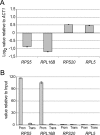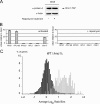Hmo1 is required for TOR-dependent regulation of ribosomal protein gene transcription
- PMID: 17875934
- PMCID: PMC2169146
- DOI: 10.1128/MCB.01102-07
Hmo1 is required for TOR-dependent regulation of ribosomal protein gene transcription
Abstract
Ribosome biogenesis requires equimolar amounts of four rRNAs and all 79 ribosomal proteins (RP). Coordinated regulation of rRNA and RP synthesis by eukaryotic RNA polymerases (Pol) I, III, and II is a key requirement for growth control. Using a novel global genetic approach, we showed that the absence of Hmo1 becomes lethal when combined with mutations of components of either the RNA Pol II or Pol I transcription machineries, of specific RP, or of the TOR pathway. Hmo1 directly interacts with both the region transcribed by Pol I and a subset of RP gene promoters. Down-regulation of Hmo1 expression affects RP gene expression. Upon TORC1 inhibition, Hmo1 dissociates from ribosomal DNA (rDNA) and some RP gene promoters simultaneously. Finally, in the absence of Hmo1, TOR-dependent repression of RP genes is alleviated. Therefore, we show here that Saccharomyces cerevisiae Hmo1 is directly involved in coordinating rDNA transcription by Pol I and RP gene expression by Pol II under the control of the TOR pathway.
Figures







References
-
- Alekseev, S. Y., S. V. Kovaltsova, I. V. Fedorova, L. M. Gracheva, T. A. Evstukhina, V. T. Peshekhonov, and V. G. Korolev. 2002. HSM2 (HMO1) gene participates in mutagenesis control in yeast Saccharomyces cerevisiae. DNA Repair 1:287-297. - PubMed
-
- Bauerle, K. T., E. Kamau, and A. Grove. 2006. Interactions between N- and C-terminal domains of the Saccharomyces cerevisiae high-mobility group protein HMO1 are required for DNA bending. Biochemistry 45:3635-3645. - PubMed
-
- Belli, G., E. Gari, M. Aldea, and E. Herrero. 1998. Functional analysis of yeast essential genes using a promoter-substitution cassette and the tetracycline-regulatable dual expression system. Yeast 14:1127-1138. - PubMed
Publication types
MeSH terms
Substances
LinkOut - more resources
Full Text Sources
Molecular Biology Databases
